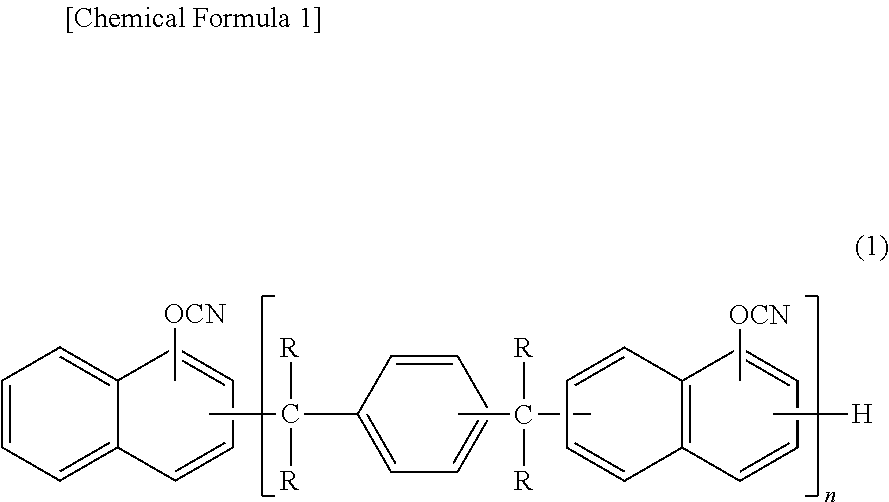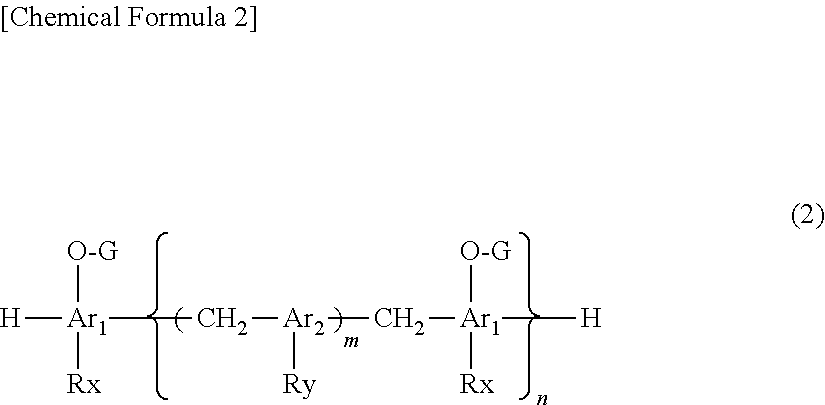Prepreg and laminate
a technology of laminate and pre-preg, which is applied in the field of pre-preg, can solve the problems of poor connection between the semiconductor element and the printed wiring board of the semiconductor plastic package or between, the limit of responding to the demand for high heat resistance, and the decrease of drillability, so as to achieve high rigidity, low thermal expansion coefficient, and high reliability.
- Summary
- Abstract
- Description
- Claims
- Application Information
AI Technical Summary
Benefits of technology
Problems solved by technology
Method used
Image
Examples
synthesis example 1
Synthesis-1 of α-Naphthol Aralkyl Type Cyanate Resin
[0036]103 g (OH group 0.47 mole) of α-naphthol aralkyl resin (SN485, OH group equivalent: 219 g / eq., softening point: 86° C., made by Nippon Steel Chemical Co., Ltd.) represented by the following general formula (3):
[0037]
is dissolved in 500 ml of chloroform, and added and mixed with 0.7 mole of triethylamine, which is added dropwise to 300 g of a solution of 0.93 mole of cyanogen chloride in chloroform at −10° C. over 1.5 hours and stirred for 30 minutes, and added dropwise with a mixed solution of 0.1 mole of triethylamine and 30 g of chloroform and stirred for 30 minutes to complete the reaction. The resulting triethylamine hydrochloride is filtered off, and the thus obtained filtrate is washed with 500 ml of 0.1 N hydrochloric acid and then washed with 500 ml of water four times. Next, a chloroform layer is extracted from the chloroform / water mixed solution by separation treatment, and then sodium sulfate is added to the chloro...
synthesis example 2
Synthesis-2 of α-Naphthol Aralkyl Type Cyanate Resin
[0039]An α-naphthol aralkyl type cyanate resin represented by the above general formula (4) is synthesized by the same method as in Synthesis Example 1 except that 102 g (OH group 0.45 mole) of α-naphthol aralkyl resin (SN4105, OH group equivalent: 226 g / eq., softening point: 105° C., made by Nippon Steel Chemical Co., Ltd.) is used in stead of the α-naphthol aralkyl resin (SN485, OH group equivalent: 219 g / eq., softening point: 86° C., made by Nippon Steel Chemical Co., Ltd.) and the amount of cyanogen chloride used is 0.90 mole. In an infrared absorption spectrum is confirmed an absorption of cyanate group in the proximity of 2264 cm−1. Also, the conversion from OH group to OCN group as calculated from 13C-NMR and 1H-NMR is not less than 99%. Furthermore, from differential refractive index detection in GPC, the percentage of compounds with n of 1 to 4 is 75% by weight.
Compounding Example 1
[0040]60 parts by weight of α-naphthol ar...
example 9
Compounding Example 9
[0048]A varnish is obtained in the same manner as in Compounding Example 1 except that the amount of spherical fused silica (SC2050MB, made by Admatechs Co., Ltd.) in Example 1 is changed to 200 parts by weight.
[0049]
PUM
| Property | Measurement | Unit |
|---|---|---|
| thickness | aaaaa | aaaaa |
| diameter | aaaaa | aaaaa |
| diameter | aaaaa | aaaaa |
Abstract
Description
Claims
Application Information
 Login to View More
Login to View More - R&D
- Intellectual Property
- Life Sciences
- Materials
- Tech Scout
- Unparalleled Data Quality
- Higher Quality Content
- 60% Fewer Hallucinations
Browse by: Latest US Patents, China's latest patents, Technical Efficacy Thesaurus, Application Domain, Technology Topic, Popular Technical Reports.
© 2025 PatSnap. All rights reserved.Legal|Privacy policy|Modern Slavery Act Transparency Statement|Sitemap|About US| Contact US: help@patsnap.com



